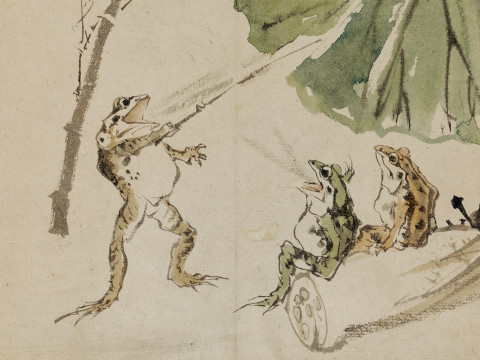
How to read it: Charles Tunnicliffe's Chinese Geese
By RA Collections team
Published on 25 July 2017
Pattern and design are as important as accuracy in this wood engraving by Charles Tunnicliffe RA. Come and take a closer look...
Who was Tunnicliffe?
Known for his illustrations of Ladybird books and Tarka the Otter, Charles Tunnicliffe (1901-79) grew up on a farm in Cheshire and he depicted animals throughout his career. He explained: "by the time I was ten years old I was up in the morning with the earliest, milking the cows" – adding that "among the many farming activities, the drawing continued." Later, when given assignments as a student at the Royal College of Art, he would return to the farming subjects he knew so well. Tunnicliffe’s watercolours were hugely successful, selling out on the first day of the RA’s Summer Exhibition each year.
Tunnicliffe studied animals intensely, and often worked from dead birds, which became his library of reference material. He wrote the books Bird Portraiture in 1945 and How to Draw Farm Animals in 1947, advising that the key to success was the "close study of living creatures".
#What can I see in this print?
Made in 1937, this is a depiction of Chinese geese, recognisable from the protrusion above their beaks. Although Tunnicliffe’s drawings were factually accurate, he prioritised design, using the patterns found in nature to make a beautiful, decorative image. The patterns of the geese’s feathers are reinforced by the repetition of the row of birds, which is in turn complemented by the reflection of the birds in the water. The leaves at the bottom left and the top right and the ripples in the water add further visual interest. The black and white tones are created from cross hatched lines, which gives a geometric effect.

How was it made?
Today Tunnicliffe is largely known for his watercolours but he was a prolific book illustrator and printmaker. He used etching, aquatint, scraperboard and, as in the case of Chinese Geese, wood engraving. To create a wood engraving, the printmaker transfers a drawing onto a block of wood then incises the lines with a range of sharp metal implements. Ink is applied to the block and printed onto the paper. Although this method makes use of engraving tools, the name is misleading; "engraving" usually refers the intaglio print process, where ink is pushed into the incisions, but wood engraving is actually a relief process, where the inked surface is raised.
How to make a wood engraving
Royal Academician Anne Desmet demonstrates the traditional technique of wood engraving.
Where else might I have seen Tunnicliffe?
Tunnicliffe created artwork for many well-known books including Ladybird’s What to Look For series. His first books illustrations were for the 1932 edition of Tarka the Otter. Unaware of the limitations of book illustration at this time, at first he produced etchings with aquatint for Tarka the Otter but the publisher could not reproduce such fine images. He instead produced wood engravings which have thicker mark making and are easier to reproduce economically. It was this that started his intense period of work in the medium.

Solway Company, by 1944

Geese and Mallow, by 1944

The Spotted Sow, 1928

The Harvesters, 1925
If a composition was required with ‘Summer’ as its subject, I could think of nothing but the mowing and carting of hay. ‘Winter’ meant the hungry cattle and the big knife cutting into the hay stacks, a pig-killing scene, or a group of rough-coated colts with their tails to the weather.
Charles Tunnicliffe RA
The Royal Academy has published a catalogue raisonné of Charles Tunnicliffe RA’s prints with text from printmaking experts Robert Meyrick and Harry Heuser.
Related articles

The meteoric rise of Angelica Kauffman RA
2 January 2024

Untold Stories
26 October 2023

RA Collections Decolonial Research Project
28 March 2022

Late Constable Tour with Curator Anne Lyles
6 December 2021

